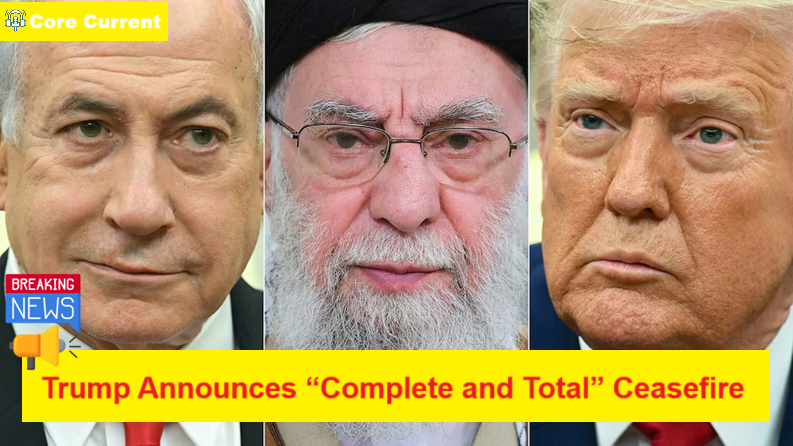Washington, D.C. — June 24, 2025 – Former U.S. President Donald Trump today declared that Iran and Israel have agreed to a “complete and total” ceasefire, effectively ending the “12‑Day War” between the two nations. The announcement, made Monday evening on Trump’s Truth Social platform, outlined a phased truce set to unfurl over 24 hours
“On the assumption that everything works as it should, which it will, I would like to congratulate both Countries, Israel and Iran, on having the Stamina, Courage, and Intelligence to end, what should be called, ‘THE 12 DAY WAR,’” Trump posted.
Details and Phasing
- First phase (Iran): Ceasefire to begin approximately six hours after the announcement.
- Second phase (Israel): Cessation of hostilities to follow an additional twelve hours later.
- Final phase: After 24 total hours, the conflict would be officially over
Trump asserted that both Israel and Iran “almost simultaneously” reached out to him seeking peace, prompting his declaration .
Mixed Reactions and Confusion
Despite Trump’s pronouncements, Iran’s Foreign Minister Abbas Araghchi refuted any formal ceasefire agreement, stating Tehran would halt attacks only if Israel ceased its operations by 4 a.m. Tehran time (around 8:30 p.m. ET).
Shortly after Israel affirmed it had accepted the ceasefire proposal—following Trump’s coordination with Prime Minister Netanyahu and Qatari mediators—the pact began to unravel. Within hours, both countries accused each other of renewed strikes
Immediate Ceasefire Breaches
- Iran’s missiles: Israel reported Iranian missile launches targeting Beersheba, claiming four civilians were killed and 20 injured. Iran denied any post-ceasefire activity
- Israeli retaliation: In response to alleged missile launches, Israel resumed strikes on Tehran, prompting stern warnings from Trump
Trump’s Forceful Intervention
While boarding Air Force One en route to a NATO summit in The Hague, Trump expressed deep frustration:
“I’m not happy with Israel. . . . they dropped a load of bombs, the likes of which I’ve never seen before.”
“We basically have two countries that have been fighting so long and so hard that they don’t know what the f‑‑‑ they’re doing.”
Trump further tweeted a direct warning:
“ISRAEL. DO NOT DROP THOSE BOMBS. IF YOU DO IT IS A MAJOR VIOLATION. BRING YOUR PILOT’S HOME, NOW!” He expressed similar disappointment toward Iran but singled out Israel’s actions as particularly disturbing .
Diplomatic Channels and Mediation
Trump credited Qatar with key mediation efforts, while Vice President JD Vance, Secretary of State Marco Rubio, Middle East envoy Steve Witkoff, and Trump himself utilized private and public channels to negotiate with both countries
Qatari officials also expressed deep concern over the conflict’s spillover—especially Iran’s missile attack on Al‑Udeid Air Base in Qatar, described as “unacceptable”
Casualties and Humanitarian Fallout
- Iran: Israeli air raids have resulted in at least 600 rescues; over 600 Iranian military and civilian personnel have reportedly died .
- Israel: At least five fatalities and more than eight injured have been confirmed from missile impacts
- Palestinian civilians in Gaza are also suffering ongoing hardships, with at least 25 killed during humanitarian distribution in the latest escalation
Future of the Truce
While Trump has urged both nations to honor the ceasefire, no formal monitoring mechanism is in place. Qatar remains actively engaged in diplomatic oversight, but the truce’s tenuous nature means any new strike—whether deliberate or accidental—could reignite hostilities
International leaders, including those from the EU, France, Australia, and the UK, have urged vigilance and continued de‑escalation. French diplomats emphasized the urgency of resuming nuclear and ballistic arms negotiations with Iran .
What Comes Next?
- Verification efforts: No neutral party has been given authority to monitor ceasefire compliance—raising the risk of unverified violations escalating further.
- Diplomatic follow‑up: Talks are expected to continue through Qatari back‑channels and U.S. envoys, though Iran has yet to formally confirm the truce .
- Regional dynamics: The conflict’s echoes are resonating across the Middle East, with ramifications for Gaza, Iraqi bases, and Gulf stability. Drone and missile activity in Iraq and Yemen continues to threaten broader escalation .
Bottom line: Former President Trump’s pronouncement of a phased, “complete and total” ceasefire marks a high-stakes diplomatic intervention in a rapidly escalating regional conflict. Yet despite this high-profile effort, early violations by both Iran and Israel—coupled with the absence of any formal verification—underscore the fragility of the truce. As global attention turns to diplomatic leverage and preventing further escalation, the question remains: can Trump’s intervention hold, or will history repeat itself?
